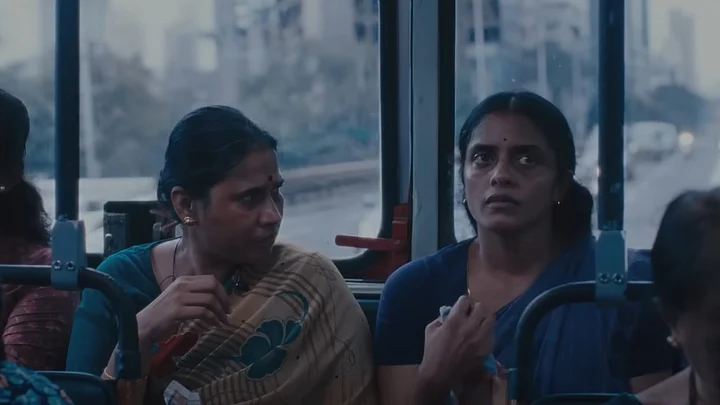For decades, Mumbai has been called the ‘city of dreams’, the one that ‘never sleeps’ and that’s the idea of Mumbai that exists in the monsoon reels taken from high-rise buildings. But the reality of Mumbai is much more complex – the ‘city of dreams’ is made up of infinite pockets of people trying to make this city their home even as its relentless ‘speed’ makes it difficult for roots to form.
One of these infinite pockets is the space in which the protagonists of Payal Kapadia’s All We Imagine as Light exist. Prabha (Kani Kusruti) and Anu (Divya Prabha) are nurses in a specialty hospital in Mumbai – Prabha has seemingly worked her way up the ranks in all her time in the city. Then there’s Parvaty (Chhaya Kadam) who worked in the hospital’s mess.
The film’s opening sequence sets the tone for the themes the film will later explore while hinting at the director’s affection for the documentary format – Kapadia’s earlier work was the documentary A Night of Knowing Nothing. Kapadia understands how to visualise a subject’s story all while keeping the reigns of the narration in their hands and it’s one of her biggest strengths as a director.
All We Imagine as Light’s opening sequence sets up ‘Mumbai’ before it sets up the story. Everyone and everything is constantly, the constant flux making everything seem temporary. We catch small snippets of conversation, all further heightening the urban loneliness at the film’s core. Love, loneliness, and companionship are steady themes in the film.
Prabha is quiet and reclusive – she spends most of her time at work or in her rented house. Her husband left for Germany a few days after their wedding and doesn’t even call anymore – ‘Maybe he doesn’t have anything to say,’ she says. In contrast, Anu is full of energy; her excitement bordering on naiveté. She revels in the freedom the city gives her access to and is more than happy to inhabit that space with her boyfriend Shiaz (Hridhu Haroon).
Meanwhile Parvaty’s fight for stability is more tangible than the others – she faces eviction from her house at the hands of builders if she can’t find proof of ownership. Their individual struggles bind the three women together especially in the ways their identities contribute to how or how much they can fight their circumstances.
Parvathy’s identity as a woman can’t be separated from her fight – she has been so distanced from the possibility of owning her own home that, once widowed, she can’t even find the papers for the shanty.
Prabha and Anu are stuck in a tussle of their own – Prabha views Anu with a slight disdain that rises from the way patriarchy has affected her life and her views. Kusruti captures the character’s internal conflict beautifully – you can almost tell where her instincts and her empathy seem to pull her in two directions. And Anu can't help but see, in Prabha, a future she's trying to escape – the strains of keeping her interfaith relationship a secret from her family while her mother sends her one match after another gradually taking a toll on her.
Even as Mumbai comes alive in the film, there's always a ‘pull’ – towards something calmer. You can't help but identify with that familiar feeling of wanting to be anywhere else, away from the hustle and the race for a few seconds. For these three women, revolution exists simply in their decision to keep going; as it does for many around the world.
Their fight and their grief finds an almost lyrical telling thanks to Kapadia and the actors themselves. Even in the most mundane of actions, Kusruti, Kadam, and Prabha shine on screen. From the scene where Kusruti cradles a pressure cooker in the empty house and Prabha’s journey to Shiaz’s house to Parvathy throwing rocks at a billboard, All We Imagine as Light is full of moments of poetry.
The way Kapadia’s vision comes to life is also owing to cinematographer Ranabir Das. He plays with lights and shadows constantly – from lights from windows to the early rays of sunshine. In capturing the vastness of the city perfectly, he helps us stay rooted in the idea that these women's stories aren't just their own.
When we finally shift to Parvathy’s serene, seaside village in Maharashtra, it feels like a dream. The scenes in the village are best left up to you to experience. This space seems to exist somewhere between dream and reality – a light sheen plays across the screen.
And in this space, away from the crowd, all three women search for answers, closure, and solace.
The film isn't without flaws – there are some scenes that seem to stretch out a little longer than they should and the delicate balance required to tell these three stories while keeping in mind the city in which they exist sometimes stumbles. And yet, these flaws don't seem jarring – if anything, the film lingers longer than they do.
What do we talk about when we talk about a city? Do we talk about its people? Do we talk about life as it exists in it? Because while love, freedom, and joy can all exist in Mumbai and yes, sometimes dreams do come true, it's impossible to talk about the city without talking about the people at the heart of this film.
Is it fair, then, to talk about the city of dreams without talking about the stark inequalities, be it class, caste, gender, or more? As the final sequence of the film comes to a close, you can't help but wonder, if a city ‘never sleeps’, when does it ‘dream’?
All We Imagine as Light hit theatres on 22 November.
(At The Quint, we question everything. Play an active role in shaping our journalism by becoming a member today.)
